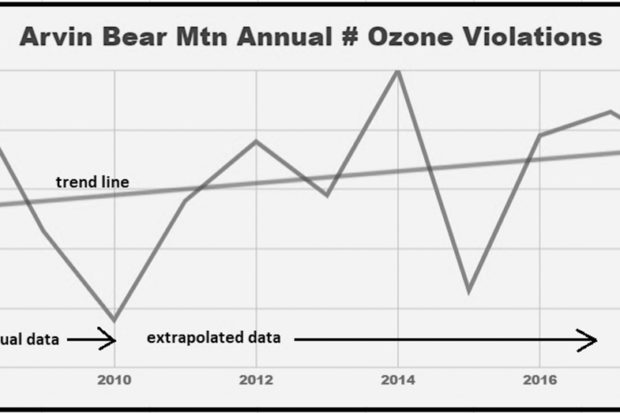
By Tom Frantz
In 1989, the California Air Resources Board (CARB) placed an air quality ozone monitor on the east side of Arvin. It was built into a shipping container and placed in the yard of the Arvin-Edison Water Storage District.
Geographically, it was just west of a grape vineyard, south of water basins used for percolating surface water, and a mile or so east of the Arvin city limits along Bear Mtn. Boulevard. To the east and south of this location, the land rose quickly into the Tehachapi Mountains with Bear Mountain looming directly overhead when the air was clear enough to see it. This monitor was called Arvin Bear Mountain on the CARB web pages.
For the next 20 years, this monitor consistently measured ozone levels that were the highest in the San Joaquin Valley and, more generally, in the entire United States. In 1979, the Environmental Protection Agency set a one-hour ozone standard based on protecting public health. In 1997, 2008 and 2012 ever tighter standards were set for average eight-hour ozone levels.
The Arvin Bear Mountain monitor had the most violations of all these standards. It was obvious that the pollution formed elsewhere in the Valley was piling up regularly against the hills immediately southeast of this rural location occupied by predominantly low-income farmworkers.
No one seemed to care about the residents of Arvin. No health studies were ever done to see what effect the worst pollution in the nation was having on these hard-working residents.
But the good-old-boy run air district in the San Joaquin Valley was getting desperate. If this situation continued in Arvin, every polluting business in the San Joaquin Valley between Stockton and Bakersfield would have to do more to decrease their emissions, which were drifting south along the Valley floor into the Arvin area.
CARB had a 20-year lease on this water district site. The lease ran out in 2009. Inexplicably, the water district refused to renew the lease. There were rumors about local farmers on this water board being upset with new CARB diesel truck rules.
The head of the air district, Seyed Sadredin, claimed to have several meetings with water district officials asking them to renew the lease but none of these meetings took place in public. No one knows what was really said, but the lease was not renewed and the bottom line was Sadredin was likely complicit in the decision.
CARB was able to get one additional year of monitoring at the site in 2010, and it quickly set up another monitor about two miles to the northwest, in a trailer. The idea was to compare the two monitors for one ozone season and then let the Bear Mountain monitor quietly disappear.
The public did not realize what had happened until the summer of 2011 when ozone readings no longer included Bear Mountain. The new monitoring site, named Arvin Di Giorgio, was looked at more closely and found to have measured ozone at significantly lower levels throughout the 2010 season when both monitors ran simultaneously.
The new monitor was consistently 12%–14% lower during the ozone season of April through October. There was a huge difference in the number and level of violations between the two sites.
Arvin Bear Mountain has been gone since 2010. Along with this monitor’s disappearance, most violations of the one-hour ozone standard also were eliminated and violations of the eight-hour standards were decreased significantly.
Until 2010, this monitor had been designated the Design Value monitor for the Valley. The Design Value is a three-year average of the annual fourth highest ozone level reading at a single monitor.
In 2010, the Design Value was around 104 ppb (parts per billion). With Bear Mountain gone, the Design Value rapidly dropped to 94 ppb in 2013 but it has stayed there ever since. In other words, there was an instant, artificial improvement in air quality across the San Joaquin Valley with this monitor’s removal.
With the 2010 data, we know directly how Bear Mountain compared to the new monitor, Di Giorgio, and it is possible to extrapolate the probable readings for Arvin Bear Mountain in the years since 2010. Doing this simple math with a conservative factor of +11% it is clear that there has been no improvement in Arvin’s air quality over the past eight years (2011–2018). This is apparent in the accompanying chart showing the past actual readings and the calculated number of violations per year after 2010.
Air quality advocates in the San Joaquin Valley made an issue of this monitor’s disappearance during the summer of 2012. Shortly thereafter, the head of CARB, Mary Nichols, wrote a letter to the Arvin-Edison Water Storage District board of directors, basically demanding that they allow the monitor to return (https://airqualityguy.files.wordpress.com/2018/11/arb-letter-to-arvin-edison-20121008.pdf). Unfortunately, the water district ignored the letter, called her bluff, and she never followed up.
Nichols has two more years left as head of CARB. It is past time for her to do the right thing and restore that ozone monitor to its original location and settings. Because pollution emissions will have to be reduced everywhere in the Valley in order for Arvin to meet the air quality health standards, this move will be good for communities everywhere. You could say that as Arvin goes, so goes the Valley.
*****
Longtime clean air advocate Tom Frantz is a retired math teacher and Kern County almond farmer. A founding member of the Central Valley Air Quality Coalition (CVAQ), he serves on its steering committee and as president of the Association of Irritated Residents. The CVAQ is a partnership of more than 70 community, medical, public health and environmental justice organizations representing thousands of residents in the San Joaquin Valley unified in their commitment to improving the health of Californians. For more information, visit www.calcleanair.org.
